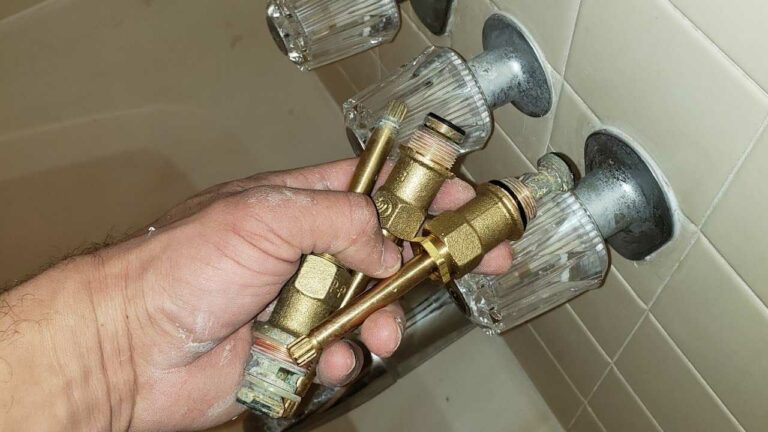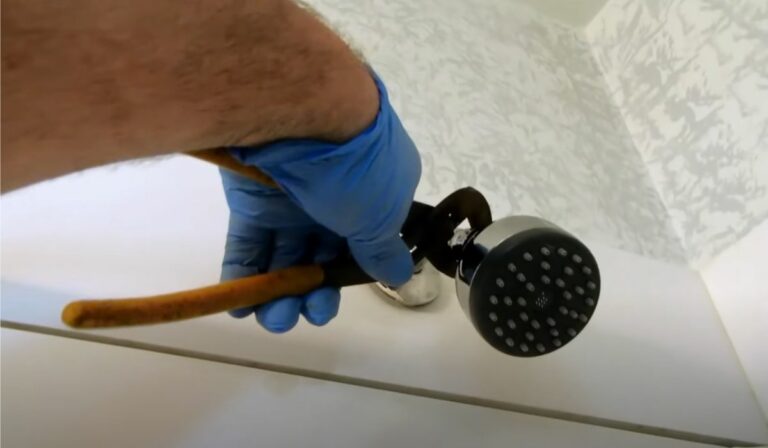Types of Shower Diverters: Understanding the Difference
To find out about shower diverters, one needs to dig deep into the concept of exactly how the water inside the shower system makes its way to the showerhead, handheld shower, or faucet.
This is the unit in charge of directing the water supply to multiple outlets. And this can be done in many ways thanks to the several types of shower diverters existing.
Generally, there are 3-valve diverters,2-valve diverters, and tee diverters. However, there are also other common types, including pressure-balanced, thermostatic, manual, push-button, integrated, stacked, shower arm, diverter tub spout, and 4-way diverter.
In this guide, let’s explore these shower diverter types and also discuss the important factors in picking the right type for your needs.
First Get a Quick Idea on How Does a Shower Diverter Work
Before jumping into its functionality, you could be wondering what a shower diverter looks like. Well, each type of shower diverter looks slightly different than the others. But below is a picture of a typical body.
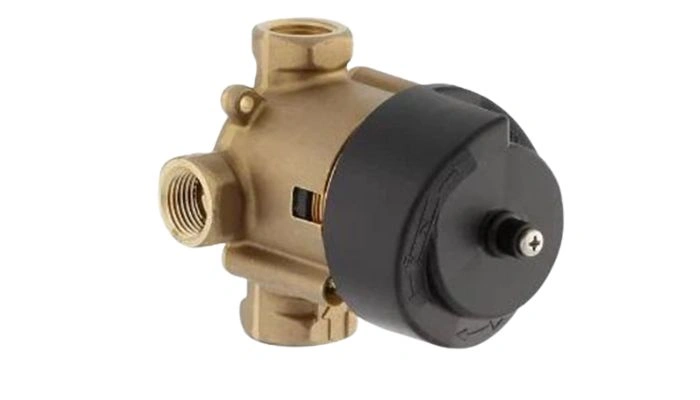
To understand the mechanism, let’s take the example of a combination bathtub and shower. There should be a faucet handle that allows changing the water flow from the tub spout to a shower head and vice versa.
The handle actually triggers the shower diverter that stays behind the wall. A water pipe is what allows the water to travel towards the tub faucet here.
This is not visible, but the pipe actually extends vertically to the showerhead. So that the water is diverted to the head whenever you open the diverter valve. On the other hand, when the diverter valve is closed, the water redirects back down to the tub spout.
Diverter and Valve Is Often Now Same
Now keep in mind that a diverter and a transfer valve may not be the same thing in a shower system. But how do you differ between these? Exactly what is the difference between a diverter and atransfer valve?
The main difference between diverter and transfer valves comes from their mechanism of directing water supply. A typical diverter will help in switching the water flow between a shower and a tub. This means the showerhead or tub solely receives the water flow. However, the transfer valve can send water to more than one outlet.
It may seem like the purpose of a shower diverter is solely to redirect water. However, there’s actually more to that.
Once You Install a Shower Diverter:
The 3 Main Types of Shower Diverters
The categories of shower diverters are quite a lot. But let’s find out about the major ones first. So what are the different types of diverters?
There are but mainly three types of diverters. These are the 3-valve diverter, 2-valve diverter, and single-valve diverter. Depending on different outlet requirements, you may need to choose one over another.
3-Valve Shower Diverter
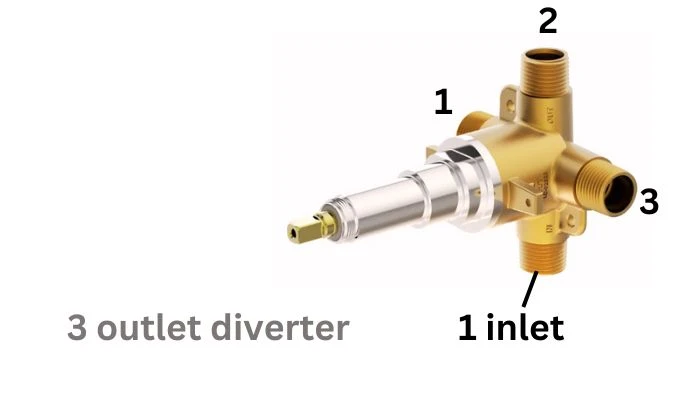
The 3-valve diverter is also referred to as a 3 function shower diverter. So exactly what is a 3-function shower diverter?
A 3-function shower diverter is a type that allows 3 different mechanisms for water flow. Here 2 functions include separate water flow for 2 different outlets. And one shared function that allows water supply to both outlets at the same time.
But how does that happen? Exactly how does a 3-valve diverter work for shower systems?
So a 3-way shower diverter valve works by providing access to both hot and cold water for a shower system. These are common for showers that have hot water, cold water, and a third wheel mode for the correct combination of hot and cold water.
Bathtub faucets that come with individual handles for cold and hot water use this type of shower diverter. It stays between both handles.
To Use a 3-Valve Shower Diverter:
2-Valve Shower Diverter
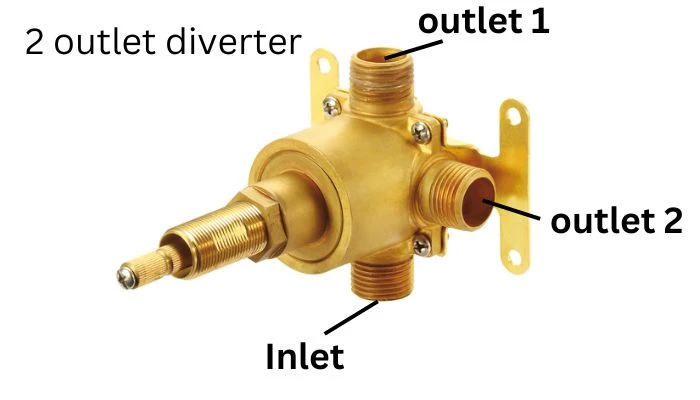
A 2-valve shower diverter often stays on two-tap and one-tap faucets. You can find these in the middle of a faucet. But exactly what is a 2 function diverter, also known as a two-valve shower diverter?
A 2 function diverter basically uses a rotating control for cold and hot water. There is one more control that helps in diverting water between the shower and tub.
With the 3-valve diverter, the hot or cold water goes directly toward the shower head. However, in the case of a 2-valve diverter, the water must be completely mixed. And then, it travels to the shower head.
However, using a 2-valve shower diverter is the same as how you would use a 3-valve diverter.
Tee Shower Diverter
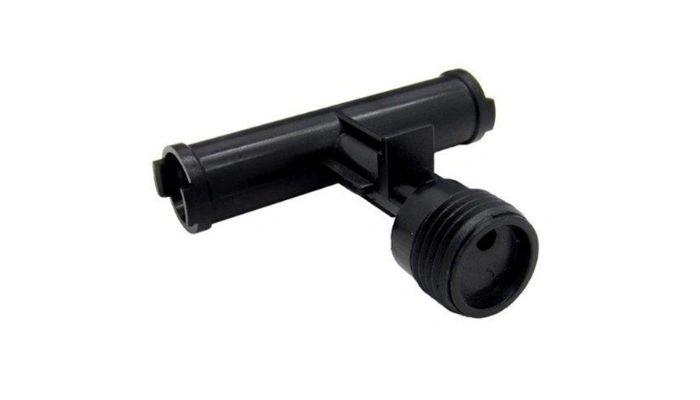
Any guesses on what is the most common shower diverter? Well, it is the third type of shower diverter that we are about to discuss.
The most common shower diverter is the single valve or T diverter. This is the type that allows pushing down the handle to open water to the tub spout. It is great for both one-tap and two-tap faucets.
You should be able to locate this diverter at the end of the faucet. No matter where the diverter stays, it can work for both two-tape and one-tape faucets. The mechanism of this diverter is completely different from the previous two shower diverter types.
To Use a Tee Shower Diverter:
More Common Types of Shower Diverters
Now that you know about the main three categories, I’ll just help you familiarize yourself with the other common types of shower diverters.
1. Pressure-Balanced Shower Diverters
This is the type of shower diverter that focuses on maintaining water pressure and reducing fluctuations. So that the water stream is steadier even with the use of other water sources.
Pressure-balanced shower diverters are great for scald prevention as they help with the compensation of temperature changes by balancing water pressure.
2. Thermostatic Shower Diverters
This shower diverter type is often best for houses with the elderly and children. As the diverter automatically controls the temperature of water to keep it within a safe margin.
Thermostatic shower diverters offer a feature for pre-setting the water temperature, which makes the whole thing quite convenient.
3. Manual Shower Diverters
Just like the name suggests, this shower diverter type works with manual operation. You need to manually adjust the temperature and water pressure with such a diverter.
Something that may not seem user-friendly. However, it allows a lot more control over the shower, especially for bathing pets and kids.
4. Push Button Shower Diverter
To operate such a diverter type, one needs to utilize pushing and pulling. Most of these would come with a pressure balance valve equipped. However, the control options do make it quite limited. Push-button shower diverters are more common for tub and shower combinations.
5. Integrated Diverter
Usage-wise, many find the integrated diverter complex compared to other types. However, this integration style allows a full flow range and also takes less space in the bathroom. The diverter is usually installed inside the shower valve trim of a handle.
6. Stacked Diverter
This one is similar to a standalone diverter when it comes to the main function. And it basically combines the handle with the shower valve component. However, the stacked diverter will take less space than a standalone diverter.
7. Shower Arm Diverters
This shower diverter type is common for systems that accompany handheld shower heads or similar accessories. The diverter is installed on the shower arm. A lever handle or knob is available for controlling it.
8. Diverter Tub Spout
The diverter tub spout is available in the shower system’s tub spout, and you can control it through an available lever handle or knob.
And the water flow is directed towards the shower head or handheld showerhead here. So you get to enjoy multiple options for showering without requiring a dual-purpose diverter.
9. Four-Way Shower Diverter
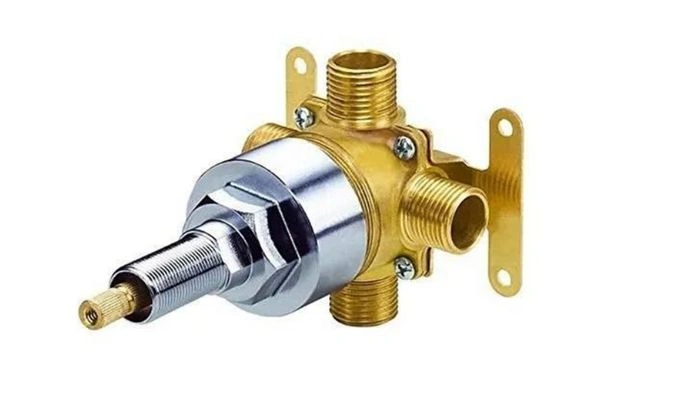
And finally, it’s the 4-way shower diverter, which is an option nowadays shower manufacturers don’t really produce. Before going there, you should understand exactly what a 4-way shower diverter is.
A 4-way shower diverter allows you to use up to four water outlets with a single inlet system. This is great for shower systems that come with an overhead shower, tub spout, hand shower, and other accessories.
Now exactly what is the use of a 4-way diverter?
Well, the use of a 4-way diverter is prominent in a bathroom where the water output requirement is more, but the water supply resource is only one. You can use two outputs at the same time with this diverter.
For example, you can have water flowing from the tub faucet and shower head at the same time in the presence of a 4-way shower diverter.
This type of shower diverter is often equipped in high-end custom showers. But then again, the market has so many better and more practical alternatives that not a lot of people go for this option.
How to Choose a Shower Diverter?
Now that the concept of all common shower diverter types is sort of clear, exactly what factors should I consider when choosing a shower diverter for my bath space? That’s what one should be wondering at this point.
So I’ve listed below some of the crucial questions you need to ask yourself when choosing a shower diverter:
By asking yourself these important questions, you will be able to get a diverter that fits the budget you have in your mind and something that would fit perfectly in your shower system.
Compatibility with the shower head and the handle is a crucial determining factor. And so is the versatility of the diverter that can allow your preferred number of shower modes/options.
If you already have a shower diverter in the system, don’t forget to check it occasionally. Pay attention to common signs that appear when the old shower diverter is not working.
Such as leaks and loss of water pressure. In such a case, you may require a shower diverter replacement. You may also try shower diverter troubleshooting if the problem is fixable.
Wrapping Up
And that’s all! Now you have pretty decent information at hand on the different types of shower diverters.
Go ahead and pick the right diverter for your bathroom. I hope my suggestions on choosing the right diverter will also help you somewhat.
Will catch you in my next guide soon. Take care!

